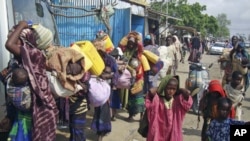The United Nations refugee agency (UNHCR) says drought and violence have now driven one-quarter of Somalia's 7.5 million people from their homes, either to internal camps or to refugee camps in neigh boring countries.
The estimate Tuesday comes as aid groups seek urgent help for Somalia, where the lack of rain has compounded chaos caused by years of civil conflict.
The UNHCR said it is especially disturbed by the high levels of malnutrition among the newest Somali refugees. It reported more than half of Somali children arriving in Ethiopia are seriously malnourished, as are about 40 percent arriving in Kenya.
It also said that tragically, many children are so weak when they arrive that they die within 24 hours despite emergency care and feeding.
The United Nations and international relief groups said persistent drought in the Horn of Africa has left up to 10 million needing food aid. The British groups Oxfam and Save the Children launched an emergency appeal this week.
The groups also are raising alarm about conditions at the Dadaab refugee camps in Kenya. The U.N. said the camps, originally built to hold 90,000 people, now hold more than 380,000.
“I was there last week. You see that they have walked a long distance. Some of them have gone days and days without eating. By the time they get to the Dadaab Refugee Camp, within 24 hours, despite emergency care, like therapeutic feeding, they still lose their lives. So it’s a very, very pathetic situation,” according to Emmanuel Nyabera, the UNHCR spokesperson based in Nairobi, Kenya.
The U.N. refugee agency reported a clash between residents and police near a food distribution point in Dadaab last Thursday. It called the incident "symptomatic" of the pressures at the overcrowded camps.
UN High Commissioner for Refugees Antonio Guterres is scheduled to visit the region later in the week and will meet with Kenyan officials next week.
To hear VOA reporter Kim Lewis' interview with UNHCR's Emmanuel Nyabera, click on the link below.










